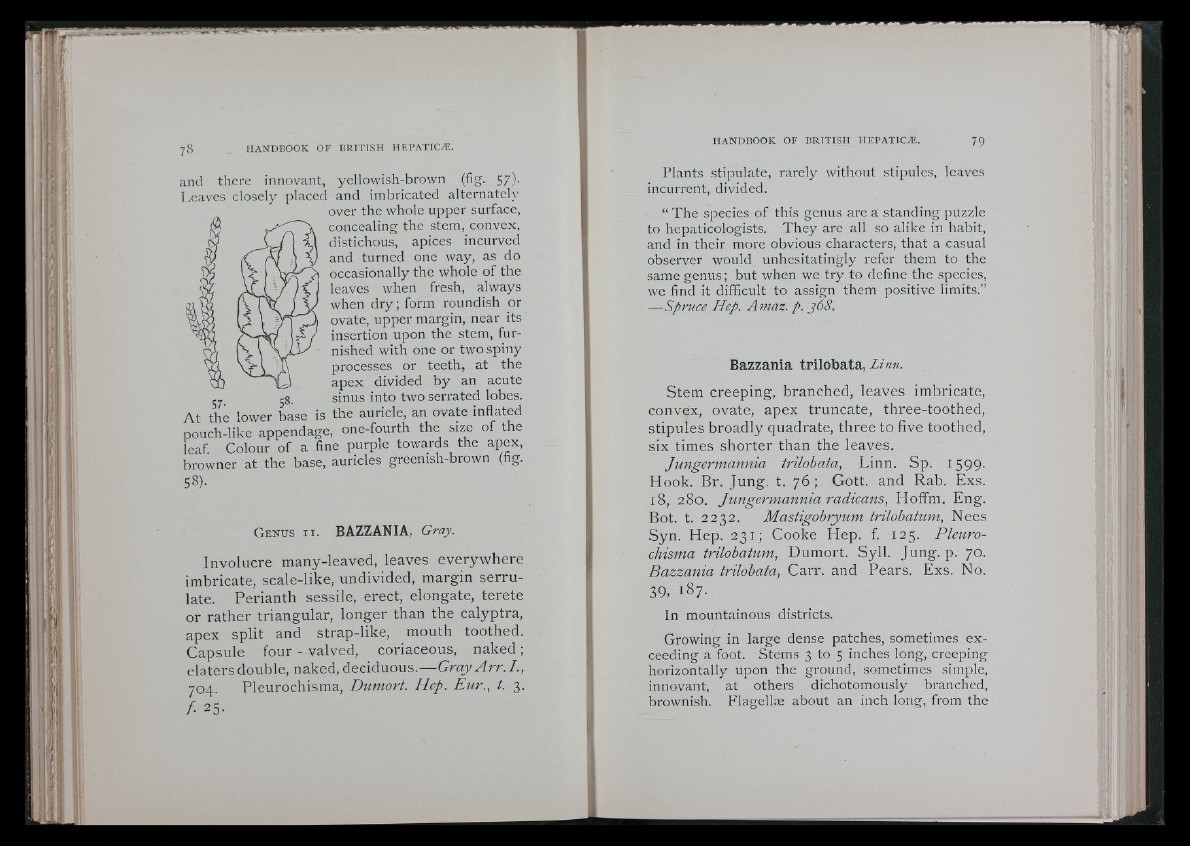
and tlicre innovant, ycllowi.sh-brown (fig. 57).
Leaves closely placed and imbricated alternate!}'
over the whole upper surface,
concealing the stem, convex,
distichous, apices incurved
and turned one way, as do
occasionally the whole of the
leaves when fresh, always
when dry; form roundish or
ovate, upper margin, near its
insertion upon the stem, furnished
with one or two spiny
processes or teeth, at the
apex divided by an acute
5g, sinus into two serrated lobes.
A t the lower base is the auricle, an ovate inflated
pouch-like appendage, one-fourth the size of the
leaf. Colour of a fine purple towards the apex,
browner at the base, auricles greemsh-brown (fig.
5 8 )-
G en u s n . BAZZANIA, Gray.
Involucre many- leaved, leaves e v e r ywh e r e
imbricate, scale-like, undivided, margin se r ru late.
Per ianth sessile, erect, elongate, terete
or rather triangular, long e r than the calyptra,
apex split and strap-like, mouth toothed.
Capsule four - valved, coriaceous, n a k e d ;
elaters double, naked, deciduous.— Gray A r r . I.,
704. Pleurochisma, Dumort. Hep. E u r ., t. 3.
f- 2 5 -
Plants stipulate, rarely without stipules, leaves
incurrent, divided.
“ The species of this genus arc a standing puzzle
to hepaticologists. They arc all so alike in habit,
and in their more obvious characters, that a casual
observer would unhesitatingly refer them to the
same genus; but when we try to define the species,
wc find it difficult to assign them positive limits.”
— Spruce Hep. A maz. p. j 68.
Bazzania trilobata, Linn.
Stem creeping, branched, leaves imbricate,
convex, ovate, apex truncate, three-toothed,
st ipules broadly quadrate, three to five toothed,
six times shorter than the leaves.
Jungermannia trilobata, Linn. Sp. 1 5 9 9 -
Hook. Br. Jung. t. 7 6 ; Co t t . and Rab. Exs.
18, 280. Jungermannia radicans, Hoffm. Eng.
Bot. t. 2232. Mastigobryum trilobatum, Nees
S yn . Hep. 231; Co o ke Hep. f. 125. Pleu ro chisma
trilobatum, Dumort. Sy ll . Jung. p. 70.
Bazzania trilobata, Carr, and Pears. Exs. No.
39, 187.
In mountainous districts.
Growing in large dense patches, sometimes e x ceeding
a foot. Stems 3 to 5 inches long, creeping
horizontally upon the ground, sometimes simple,
innovant, at others dichotomously branched,
brownish. Flagellm about an inch long, from the